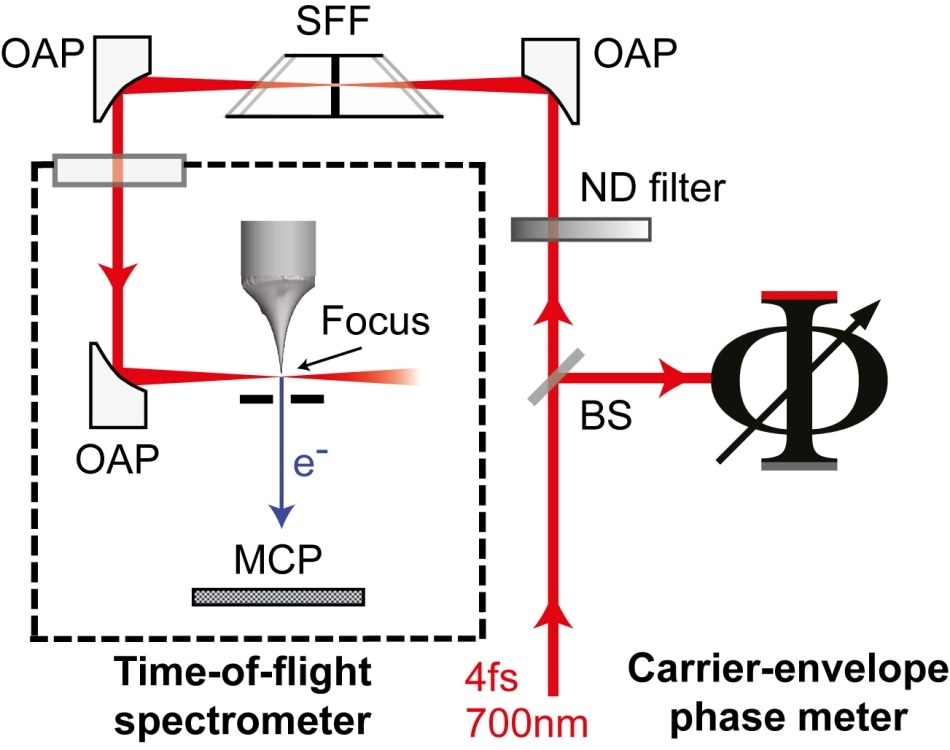Jul 14 2017
A crucial breakthrough in the research on light has been achieved by Physicists from FAU and Friedrich Schiller University Jena (FSU). They have been able to observe the properties of very short laser pulses during focusing at exceptionally high spatial and temporal resolution.
 The diagram shows the experimental set-up. The Researchers focused laser pulses (red arrows) onto a nanometer-sharp metal tip (nanotip), causing it to emit electrons. These electrons act as a kind of sensor that enables the researchers to interpret the exact form of the light wave. CREDIT: Hoff/Krüger/FAU.
The diagram shows the experimental set-up. The Researchers focused laser pulses (red arrows) onto a nanometer-sharp metal tip (nanotip), causing it to emit electrons. These electrons act as a kind of sensor that enables the researchers to interpret the exact form of the light wave. CREDIT: Hoff/Krüger/FAU.
The outcomes of the research are basically applicable to acquire in-depth knowledge of the interactions between matter and light, and will also enable regulation of movement of electrons and chemical reactions to a degree that was not possible earlier. Such understanding of basic physics will specifically benefit further analysis of innovative radiation sources and in the area of light wave electronics. The outcomes of the study were recently reported in Nature Physics, a leading Specialist Journal.
At present, ultrashort light pulses with a broad optical spectrum range in which the beams look white are used very often. Apart from other uses, they are applied to investigate the retina of the eye, and in the field of physics, they are used for regulating atomic-level processes and for investigating the processes in slow motion. In almost all these uses, the focus has to be on the white laser pulses. Since, for instance, the movement of electrons within a light wave is determined by the specific form of light wave used, it is crucial to have a detailed knowledge of the actual form of the focused laser beam.
If you wonder why it is so necessary, consider a ship sailing in stormy seas. Apart from knowing the height and length of the waves, the helmsman also has to pay attention to the incoming waves to know when the waves might hit the ship, so that a safe path can be found up to the wave’s crest on one of the sides and down on the other side. Similarly, Researchers ought to have an idea on how and at which point a light wave’s maximum will impact electrons in an application or experiment so that they have a targeted impact. The modifications to and propagation of light waves inside an electrical field happen within a few hundred attoseconds, or one billionth of a billionth of a second. Until recently, measurement of the precise distribution of peaks and troughs in a wave upon focusing a laser beam on this time scale could not be made.
At present, Scientists at Erlangen and Jena have accomplished this by focusing laser pulses on a nanometer-sharp metal tip, where the tip liberates electrons. The liberated electrons function like a sensor that allows the Scientists to understand the precise form of the light wave.
Watching light travel
Nearly 13 decades ago, Louis Georges Gouy (1854-1926), a French Physicist, discovered and reported a phase shift that ensued upon introducing interference when monochromatic light was focused. The effect was termed “Gouy phase,” and for many years, Researchers presumed that the impact will be the same for white laser spectra, which comprise of numerous colors of light. The outcomes of the joint project have enhanced the knowledge of the effect such that even in the case of short light pulses, and to hold on to the metaphor, in the future, no captain will be surprised by unanticipated waves.